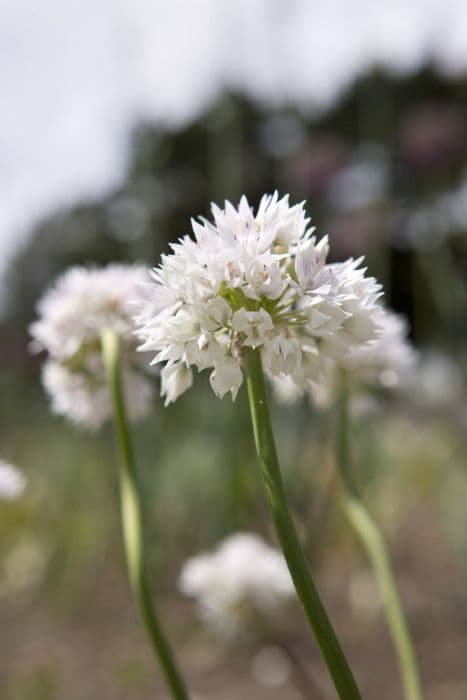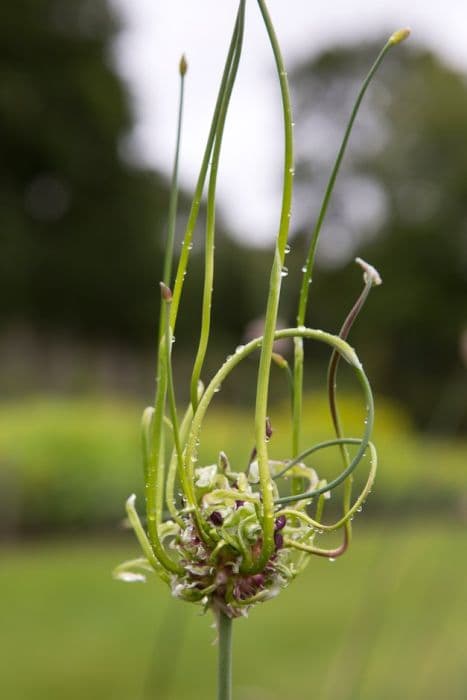Summer Drummer Allium Allium 'Summer Drummer'

ABOUT
Allium 'Summer Drummer' is a captivating ornamental onion that boasts strikingly spherical blooms. These flowers are formed by a tight cluster of tiny star-shaped florets that create a large, globe-like head. The blooms exhibit a rich and vibrant purple hue that tends to draw the eye. These globe-shaped flowers are perched atop sturdy, tall stems, which hold them aloft like floral drumsticks above the plant's foliage. The leaves of the 'Summer Drummer' are typically a lush, deep green color, with a long and strap-like appearance, creating a striking contrast against the vivid flowers. The plant exudes a simple elegance that adds vertical interest to garden beds and borders. When in full bloom, the 'Summer Drummer' is particularly attractive to pollinators such as bees and butterflies, adding not just visual beauty but also a lively buzz to the garden ambiance.
About this plant
 Names
NamesFamily
Amaryllidaceae.
Synonyms
Summer Drummer Allium, Ornamental Onion, Flowering Onion.
Common names
Allium 'Summer Drummer'.
 Toxicity
ToxicityTo humans
The ornamental onion, or Allium 'Summer Drummer', is not considered poisonous to humans. This plant, like other members of the Allium family, has edible parts that are commonly used in cooking, such as onions, garlic, chives, and leeks. However, consuming large quantities of these plants can lead to digestive discomfort. In sensitive individuals, contact with the sap can cause skin irritation. If ingested in very excessive amounts, it could potentially lead to symptoms like nausea, vomiting, and diarrhea, but this is rare as it is not commonly consumed in large quantities for it to pose a significant health risk.
To pets
Ornamental onion, specifically Allium 'Summer Drummer', is toxic to pets, including dogs and cats. Members of the Allium genus can cause hemolytic anemia in pets if ingested in large quantities. Symptoms of poisoning may include vomiting, diarrhea, abdominal pain, weakness, and lethargy. In severe cases, ingestion can lead to red blood cell damage, resulting in symptoms such as breathlessness, a high heart rate, and collapse. If a pet ingests this plant, immediate veterinary care is recommended.
 Characteristics
CharacteristicsLife cycle
Perennials
Foliage type
Deciduous
Color of leaves
Green
Flower color
Purple
Height
4-6 feet (1.2-1.8 meters)
Spread
12-18 inches (30-45 cm)
Plant type
Bulb
Hardiness zones
4-8
Native area
Asia
Benefits
 General Benefits
General Benefits- Attracts Pollinators: Allium 'Summer Drummer' produces attractive flowers that are known to draw in bees, butterflies, and other beneficial pollinators, which are essential for the pollination of many other garden plants.
- Drought Resistance: Once established, this variety of allium is fairly drought-tolerant, making it a suitable choice for gardens in drier climates or for gardeners who prefer low-maintenance plants.
- Low Maintenance: It requires minimal care beyond initial planting and occasional watering, which makes it an excellent option for both novice and experienced gardeners.
- Ornamental Appeal: With its tall stems and large purple spherical flowers, Allium 'Summer Drummer' adds height and visual interest to any garden space or floral arrangement.
- Deer and Rodent Resistant: The plants are generally resistant to deer and rodents due to their onion-like scent, reducing the likelihood of damage from these creatures.
- Perennial Growth: As a perennial, Allium 'Summer Drummer' will return year after year, offering long-term beauty in the garden with minimal need to replant.
- Easy to Combine: Its unique look complements many other plants and flowers in a garden, making it easy to combine with various perennials and annuals for a stunning display.
 Medical Properties
Medical PropertiesThis plant is not used for medical purposes.
 Air-purifying Qualities
Air-purifying QualitiesThis plant is not specifically known for air purifying qualities.
 Other Uses
Other Uses- Culinary creativity: While usually not consumed, 'Summer Drummer' could be used as a flavor experiment in avant-garde gastronomy, incorporating its petals or stalks in small amounts for a hint of onion-like flavor.
- Artistic inspiration: Artists may paint or photograph the 'Summer Drummer' due to its striking appearance, especially when in full bloom with its tall, round flower heads.
- Dye production: The plant's deep purple flowers could potentially be used to create natural dyes for textiles or crafts.
- Education and research: It can be used in botanical studies to educate students about plant biology and the Allium genus diversity.
- Floral arrangement: 'Summer Drummer' can be incorporated into dry floral arrangements, where their structural flowers provide a long-lasting decorative element.
- Wedding decorations: The tall and impressive flower stalks can be used in wedding bouquets or as part of the venue decorations for a rustic or natural-themed wedding.
- Companion planting: In the garden, 'Summer Drummer' can serve as a companion plant, potentially deterring certain pests with its strong scent.
- Fragrance extraction: Though uncommon, the aromatic scent of 'Summer Drummer' could be used in the production of fragrances or potpourri.
- Garden design: 'Summer Drummer' can be used for height and texture in garden beds, borders, or as a focal point in a landscape design.
- Photography props: The unique structure of 'Summer Drummer' flowers makes them an interesting prop for photographers, especially in macro photography.
Interesting Facts
 Feng Shui
Feng ShuiThe Allium is not used in Feng Shui practice.
 Zodiac Sign Compitability
Zodiac Sign CompitabilityThe Allium is not used in astrology practice.
 Plant Symbolism
Plant Symbolism- Strength and Patience: The Allium 'Summer Drummer', also known as Tall Allium, symbolizes both strength and patience, reflecting its robust nature and the time it takes to grow and bloom.
- Unity and Humility: The round shape of the Tall Allium's flower head represents unity and humility, with the numerous small flowers creating a cohesive whole.
- Prosperity and Abundance: With its large, impressive blooms, the Tall Allium is often associated with prosperity and abundance.
- Good Fortune: In some cultures, Tall Allium is believed to bring good luck and is often planted with the hope of attracting positive outcomes.
- Protection: Historically, alliums have been used for their strong scent to ward off evil spirits and negative energies, symbolizing protection.
 Water
WaterTall Alliums like 'Summer Drummer' should be watered deeply to encourage proper root development, usually when the top inch of soil feels dry to the touch. During the growing season, this might mean watering once or twice a week depending on weather conditions. Each watering session should provide enough water to soak the ground around the bulbs, which for an established plant could be around 1 to 1.5 gallons. It’s important not to over-water as these plants prefer well-draining soil and can rot in overly soggy conditions. Seasonal rainfall should also be taken into account, reducing the need for supplemental watering.
 Light
LightThe 'Summer Drummer' Allium thrives in full sunlight where it can receive at least six hours of direct sunlight each day. A south-facing or west-facing location is typically ideal for this plant to ensure it gets ample light. This sun exposure is essential for the development of strong stems and vibrant blooms.
 Temperature
Temperature'Summer Drummer' Alliums are hardy and can handle a range of temperatures, but they perform best in temperatures between 55 and 75 degrees Fahrenheit. They can survive winter chills down to about -20 degrees Fahrenheit and should be planted in a location where they can avoid the scorching heat of the afternoon sun in very hot summer climates.
 Pruning
PruningPruning 'Summer Drummer' Allium primarily involves deadheading the spent flowers to maintain a tidy appearance and prevent self-seeding if not desired. This can be done after the blooms have faded and throughout the summer as needed. Cut back the flower stalks to the base once they have completely died back, typically in the late summer or early fall.
 Cleaning
CleaningAs needed
 Soil
SoilThe ideal soil mix for Allium 'Summer Drummer', or Ornamental Onion, should be well-draining, with a good mix of loam, peat, and sharp sand. A slightly acidic to neutral pH range of 5.5 to 7.0 is optimal for this plant.
 Repotting
RepottingOrnamental Onion typically does not need frequent repotting and can be done every 3-4 years or when it becomes pot-bound.
 Humidity & Misting
Humidity & MistingThe Ornamental Onion fares well in average humidity conditions and does not require any special humidity adjustments.
 Suitable locations
Suitable locationsIndoor
Ensure bright light, cool temperatures, and good air circulation.
Outdoor
Plant in full sun, well-drained soil; water deeply albeit infrequently.
Hardiness zone
4-9 USDA
 Life cycle
Life cycleThe Allium 'Summer Drummer', commonly known as ornamental onion, begins its life as a bulb, which is planted in autumn. During spring, the bulb germinates, sending up long, sturdy stems and strap-shaped leaves. By early to mid-summer, spherical flower heads composed of numerous small, star-shaped flowers bloom, often reaching over 6 feet in height. After flowering, the plant sets seed, and the flower heads turn into distinctive seed heads that can add interest in the garden. As fall approaches, the foliage dies back, and the plant becomes dormant. The cycle repeats in the following spring when temperatures increase, signaling the bulb to start the growth cycle anew.
 Propogation
PropogationPropogation time
Spring-Early Summer
Propogation: Allium 'Summer Drummer', also known as ornamental onion, is typically propagated through the division of bulbs. The ideal time for this form of propagation is in the autumn once the foliage has died back. To propagate Allium 'Summer Drummer', gently lift the clump of bulbs from the soil using a spade or fork. Carefully separate the individual bulbs, being mindful not to damage them. Each bulb can then be replanted in well-drained soil at a depth three times the height of the bulb, spaced approximately 6 to 8 inches (15 to 20 centimeters) apart to allow for adequate room for growth. This method allows the plant to continue its growth cycle and produce flowers the following season.








